
Acarbose
- Klicken Sie auf QUICK INQUIRY, um ein Angebot von unserem Expertenteam zu erhalten.
- Mit qualitativ hochwertigen Produkten zu einem WETTBEWERBSFÄHIGEN Preis können Sie sich mehr auf Ihre Forschung konzentrieren.
Übersicht
Beschreibung
Acarbose is a complex oligosaccharide that acts as an inhibitor of several enzymes responsible for the breakdown of complex carbohydrates in the intestines. It is primarily used as an anti-diabetic drug to manage type 2 diabetes mellitus by controlling postprandial blood glucose levels. This compound works by inhibiting alpha-glucosidase, an intestinal enzyme that releases glucose from larger carbohydrates such as starch and sucrose .
Vorbereitungsmethoden
Synthetic Routes and Reaction Conditions: Acarbose is produced through a fermentation process involving the bacterium Actinoplanes sp. The biosynthesis involves the formation of acarviosin, which is then linked to maltose. The fermentation process is optimized by controlling the osmolality of the fermentation solution, which significantly affects the yield of this compound .
Industrial Production Methods: Industrial production of this compound involves large-scale fermentation using optimized conditions to maximize yield. The process includes the use of specific carbon sources, such as a mixture of maltose and glucose, to enhance the biosynthesis of this compound. The fermentation is carried out in bioreactors with controlled parameters such as temperature, pH, and oxygen supply .
Analyse Chemischer Reaktionen
Types of Reactions: Acarbose undergoes various chemical reactions, including hydrolysis and enzymatic degradation. It is primarily involved in inhibition reactions where it binds to alpha-glucosidase enzymes, preventing the breakdown of complex carbohydrates .
Common Reagents and Conditions: The common reagents used in the reactions involving this compound include alpha-glucosidase enzymes and substrates such as maltose and sucrose. The reactions typically occur under physiological conditions in the gastrointestinal tract .
Major Products Formed: The major products formed from the reactions involving this compound are glucose and other simple sugars, which are released from the breakdown of complex carbohydrates .
Wissenschaftliche Forschungsanwendungen
Acarbose has a wide range of scientific research applications, including:
Chemistry: this compound is used as a model compound to study enzyme inhibition and carbohydrate metabolism.
Biology: It is used to investigate the role of alpha-glucosidase in various biological processes and to study the effects of enzyme inhibition on cellular functions.
Medicine: this compound is widely used in the treatment of type 2 diabetes mellitus to control postprandial blood glucose levels. .
Industry: this compound is used in the pharmaceutical industry for the production of anti-diabetic medications. .
Wirkmechanismus
Acarbose exerts its effects by inhibiting alpha-glucosidase enzymes located in the brush-border of the intestinal mucosa. These enzymes are responsible for metabolizing oligo-, tri-, and disaccharides into absorbable simple sugars. By inhibiting these enzymes, this compound limits the absorption of dietary carbohydrates and reduces the postprandial increase in blood glucose and insulin levels . The inhibition is competitive and reversible, and this compound mimics the transition state of the substrate with its amine linkage .
Vergleich Mit ähnlichen Verbindungen
Voglibose: Another alpha-glucosidase inhibitor used to manage postprandial blood glucose levels in diabetic patients.
Miglitol: An alpha-glucosidase inhibitor that is structurally different from acarbose and voglibose.
Uniqueness of this compound: this compound is unique due to its complex oligosaccharide structure and its ability to inhibit multiple enzymes involved in carbohydrate metabolism. It has been shown to be effective in reducing postprandial blood glucose levels and improving cardiovascular outcomes in diabetic patients .
Eigenschaften
CAS-Nummer |
56810-94-0 |
|---|---|
Molekularformel |
C25H43NO18 |
Molekulargewicht |
645.6 |
Herkunft des Produkts |
United States |
Haftungsausschluss und Informationen zu In-Vitro-Forschungsprodukten
Bitte beachten Sie, dass alle Artikel und Produktinformationen, die auf BenchChem präsentiert werden, ausschließlich zu Informationszwecken bestimmt sind. Die auf BenchChem zum Kauf angebotenen Produkte sind speziell für In-vitro-Studien konzipiert, die außerhalb lebender Organismen durchgeführt werden. In-vitro-Studien, abgeleitet von dem lateinischen Begriff "in Glas", beinhalten Experimente, die in kontrollierten Laborumgebungen unter Verwendung von Zellen oder Geweben durchgeführt werden. Es ist wichtig zu beachten, dass diese Produkte nicht als Arzneimittel oder Medikamente eingestuft sind und keine Zulassung der FDA für die Vorbeugung, Behandlung oder Heilung von medizinischen Zuständen, Beschwerden oder Krankheiten erhalten haben. Wir müssen betonen, dass jede Form der körperlichen Einführung dieser Produkte in Menschen oder Tiere gesetzlich strikt untersagt ist. Es ist unerlässlich, sich an diese Richtlinien zu halten, um die Einhaltung rechtlicher und ethischer Standards in Forschung und Experiment zu gewährleisten.


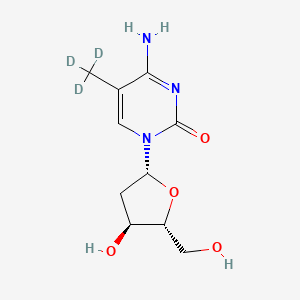
![Tert-butyl-7-[4-(4-fluorophenyl)-6-isopropyl-2-methylsulfonylpyrimidin-5-YL]-(3R,5S)-isopropylidene-(E)-6-heptenoate](/img/structure/B1140539.png)
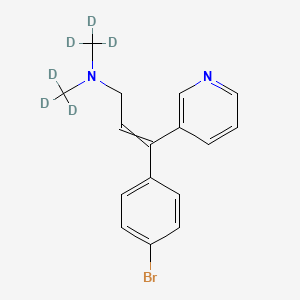
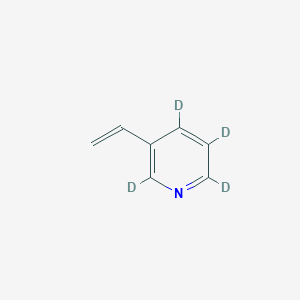
![4-[1-(4-Iodophenyl)-5-(2,4-dinitrophenyl)-formaz-3-yl]-1,3-benzene Disulfonate, Disodium Salt](/img/structure/B1140545.png)
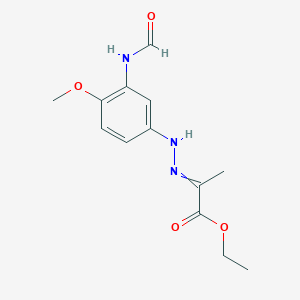
![(7S,11S,12S,13S,14R,15R,16R,17S,18S)-1'-tert-butyl-2,13,15,17,32-pentahydroxy-11-methoxy-3,7,12,14,16,18,22-heptamethylspiro[8,33-dioxa-24,27,29-triazapentacyclo[23.6.1.14,7.05,31.026,30]tritriaconta-1(32),2,4,9,19,21,24,26,30-nonaene-28,4'-piperidine]-6,23-dione](/img/structure/B1140550.png)
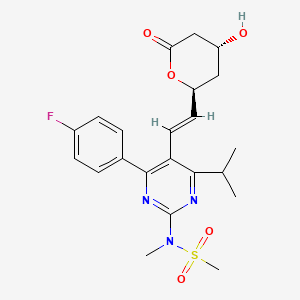
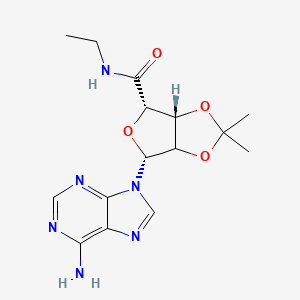
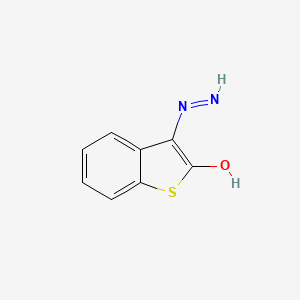
pyrimidine-2,4-dione](/img/structure/B1140558.png)
